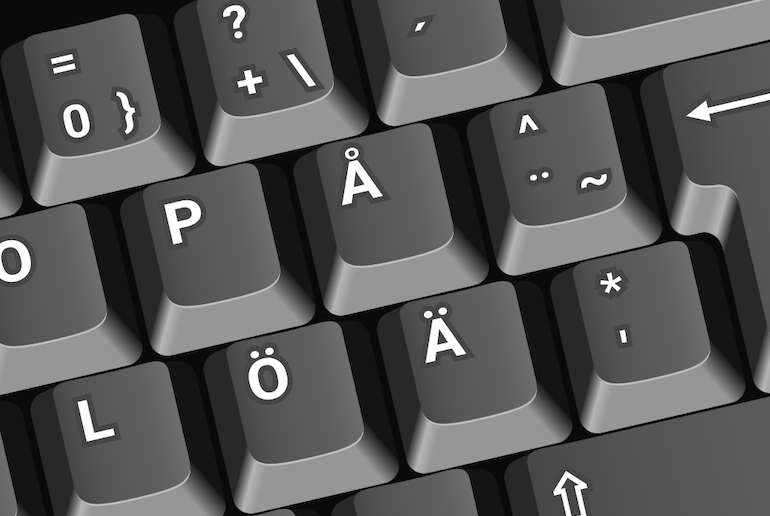Okay, you’re unlikely to need to learn Swedish to get by on a holiday in Sweden – after all, most Swedes speak good English. But you will see Swedish words written and may wonder about the alphabet and pronunciation.

Recent surveys show that 95 percent of Swedes speak at least some English, which is considerably more than most Brits and Americans speak Swedish!
But it’s always fun to have a go at a new language and to try pronouncing some phrases. And, most Swedes will be thrilled if you can come up with a few Swedish phrases (and pronounce them correctly!).
So, read on to find out all about Swedish writing, the Swedish language, how many letters in the Swedish alphabet and how to pronounce Swedish letters.
The Swedish language
Swedish is a Scandinavian language that derives from Old Norse, like its neighbouring languages Norwegian and Danish.

Most Norwegians and Swedes can understand each other’s languages pretty well, and Danes can usually understand Swedish and Norwegian too. Swedes and Norwegians, though, often have problems with the Danish pronunciation.
The Swedish language is spoken by some ten million people, most of whom live in Sweden, though there’s also a sizeable population of Finns who speak Swedish.
How many letters are in the Swedish alphabet?
The Swedish alphabet has 29 letters, the same 26 (A–Z) that the English alphabet has, plus three additional Swedish letters – Å, Ä and Ö. It’s made up of 20 consonants and nine vowels.

Y is sometimes considered a vowel in Swedish rather than a consonant – so the vowels are A, E, I, O, U and Y plus the three Swedish symbols Å, Ä and Ö.
What are the Swedish accent marks?
Of the three Swedish symbols, two have an umlaut above them (Ä and Ö) and one (Å) has a krouzek, also called a ring. However, in Swedish these are not considered to be letters with accents above them, but as fully independent letters in themselves, which appear at the end of the Swedish alphabet and as distinct keys on a Scandinavian keyboard.
Note that when Swedes write Ä and Ö by hand, rather than on a keyboard, they often merge the two dots to form a line above the A and O.
Swedish alphabet pronunciation
Although many Swedish consonants have a similar pronunciation to English ones, Swedish vowel pronunciation can be quite tricky. Swedish vowels can either be long (when they’re at the end of a word or followed by one consonant) or short (when they’re followed by two consonants).
The Swedish letter Ä is pronounced like an English e, as in “get”, while Ö has a longer sound, as in “fur”. Å can be pronounced either long (as in “raw”) or short (as in “hot”).
The consonants B, D, F, H, L, M, N, P, R, T, V and X have a similar pronunciation as in English. Click here for further details of the Swedish vowels and consonants with their phonetic spellings, plus a brief explanation on how to pronounce them.
There are also some particular combinations of letters that have a specific sound. The letter J, for example, when following some other consonants, changes the sound of the letter it follows. For example: Dj, Gj, Hj, Lj are all pronounced like the English Y, while Tj and Kj are pronounced like the English Sh.
For more on Swedish letters’ pronunciation check out this clip below.
How to type Swedish letters
The Swedish keyboard is very similar to the classic Latin QWERTY board, but with the three extra letters (Å, Ä and Ö) included at the end of two rows on the righthand side of the keyboard.
In order to type those letters on an American or British keyboard, you can just hold down the A or O keys and the accented options will come up (on a Mac, at least!).

Speaking Swedish like a Swede
Few foreigners really get the hang of the sing-song sound of the Swedish language. It has a distinctive melody (think the Swedish chef in The Muppets), due to the use of two different tones on words of two syllables or more. One type of tone rises throughout the word, while the other falls in the middle then rises again at the end of the word.
The same word can have two different meanings according to which tone is used. For example, the word buren can mean “cage” or “carried” depending on which tone is used.
Sounds complicated? Well, yes but most Swedes are aware of the confusion this can cause foreigners and will be able to work out which word you mean from the context. So, don’t be afraid to have a go!










“The same word can have two different meanings according to which tone is used. For example, the word anden, when said with one type of intonation means “duck”. Using a different intonation, it means “spirit”.”
This is not correct.
“anden” is “the duck” in Danish.
In Swedish a duck is called “anka”
We removed that reference! Thanks.
Actually both “anka” and “and” are types of duck in Swedish. So that original reference is correct.